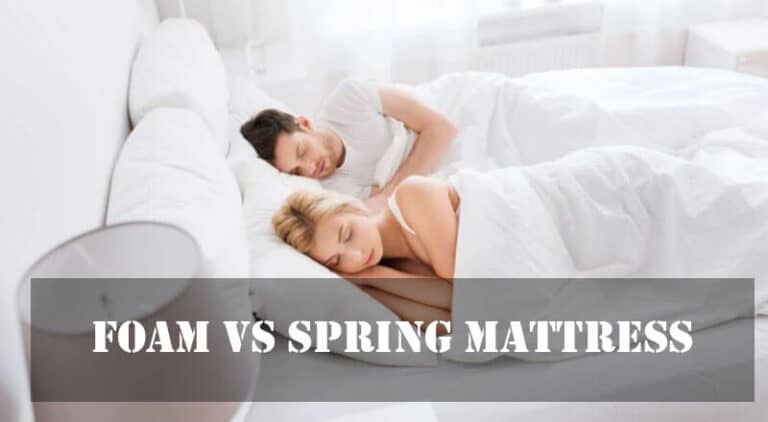Foam vs Spring Mattress: What's the Difference?
When it comes to choosing a new mattress, the options can seem endless. One of the biggest decisions you'll have to make is whether to go with a foam or spring mattress. But what exactly is the difference between these two types of mattresses? Let's explore the main differences and help you decide which one is right for you.
Foam vs Spring Mattress: Which One is Better?
Before we dive into the differences between foam and spring mattresses, you may be wondering which one is better. The truth is, it all depends on your personal preferences and needs. Both types of mattresses have their own set of advantages and disadvantages, so it's important to consider your sleeping habits and comfort preferences before making a decision.
Foam vs Spring Mattress: Pros and Cons
Before making a decision, it's important to weigh the pros and cons of both foam and spring mattresses. Foam mattresses are known for their pressure-relieving properties and can be a better option for those with back pain. However, they may retain heat and can be more expensive. On the other hand, spring mattresses offer more bounce and can be more affordable, but may not provide enough support for some sleepers.
Foam vs Spring Mattress: Comfort Comparison
When it comes to comfort, both foam and spring mattresses have their own unique features. Foam mattresses are known for their ability to conform to your body and relieve pressure points, making them a great option for side sleepers. Spring mattresses, on the other hand, provide more bounce and can be a better choice for stomach and back sleepers.
Foam vs Spring Mattress: Durability Comparison
One of the biggest differences between foam and spring mattresses is their durability. Foam mattresses tend to last longer than spring mattresses, with an average lifespan of 10-15 years. However, the exact lifespan will depend on the quality and density of the foam. Spring mattresses, on the other hand, may need to be replaced every 5-8 years.
Foam vs Spring Mattress: Support Comparison
When it comes to support, both foam and spring mattresses have their own strengths. Foam mattresses can provide targeted support to different parts of the body, making them a great option for those with back pain. Spring mattresses, on the other hand, offer more overall support and can be a better choice for heavier individuals.
Foam vs Spring Mattress: Price Comparison
Price is often a major factor when choosing a new mattress. Foam mattresses tend to be more expensive than spring mattresses, with high-quality foam mattresses costing upwards of $1000. Spring mattresses, on the other hand, can be more affordable, with options available for under $500.
Foam vs Spring Mattress: Motion Isolation Comparison
If you share a bed with a partner, you may be concerned about motion transfer. Foam mattresses are known for their ability to absorb movement, making them a great option for couples. Spring mattresses, on the other hand, may transfer more motion, which could be disruptive for light sleepers.
Foam vs Spring Mattress: Heat Retention Comparison
One common complaint about foam mattresses is that they can retain heat, making some sleepers feel hot and uncomfortable. However, advances in foam technology have led to the development of cooling foams that can help regulate temperature. Spring mattresses, on the other hand, typically do not retain heat.
Foam vs Spring Mattress: Maintenance Comparison
Another factor to consider is the maintenance required for each type of mattress. Foam mattresses may need to be rotated every 3-6 months to prevent sagging, while spring mattresses may need to be flipped and rotated every few months. However, foam mattresses may be easier to spot clean if there are any spills or stains, while spring mattresses may require more intensive cleaning methods.
The Difference between Foam and Spring Mattress

Foam Mattress: A Modern Choice for Comfort and Support
 When it comes to choosing a mattress, one of the most important factors is comfort. After all, a good night's sleep is essential for our overall well-being. In recent years, foam mattresses have gained popularity due to their ability to provide both comfort and support. These mattresses are made from layers of foam, including memory foam and polyurethane foam, which contour to the body and distribute weight evenly. This results in a feeling of weightlessness and reduces pressure on joints, making it an ideal choice for those with back and joint pain. Additionally, foam mattresses are known for their motion isolation, meaning you won't feel your partner's movements during the night, allowing for a more restful sleep.
When it comes to choosing a mattress, one of the most important factors is comfort. After all, a good night's sleep is essential for our overall well-being. In recent years, foam mattresses have gained popularity due to their ability to provide both comfort and support. These mattresses are made from layers of foam, including memory foam and polyurethane foam, which contour to the body and distribute weight evenly. This results in a feeling of weightlessness and reduces pressure on joints, making it an ideal choice for those with back and joint pain. Additionally, foam mattresses are known for their motion isolation, meaning you won't feel your partner's movements during the night, allowing for a more restful sleep.
Spring Mattress: A Classic Option with Bounce and Durability
 On the other hand, spring mattresses have been a traditional choice for many years. These mattresses use steel coils as the primary support system, providing a bouncy feel. The thicker the coils, the firmer the mattress. This option is suitable for those who prefer a firmer sleeping surface and need more support. Additionally, spring mattresses have good airflow, making them a cooler option for those who tend to overheat while sleeping. They also tend to be more durable than foam mattresses, with a longer lifespan.
On the other hand, spring mattresses have been a traditional choice for many years. These mattresses use steel coils as the primary support system, providing a bouncy feel. The thicker the coils, the firmer the mattress. This option is suitable for those who prefer a firmer sleeping surface and need more support. Additionally, spring mattresses have good airflow, making them a cooler option for those who tend to overheat while sleeping. They also tend to be more durable than foam mattresses, with a longer lifespan.
Which Mattress is Right for You?
 Both foam and spring mattresses have their own unique features, and the choice ultimately depends on personal preference. If you prioritize comfort and pressure relief, a foam mattress may be the best choice for you. On the other hand, if you prefer a firmer, more traditional feel, a spring mattress may be the way to go. It's essential to test out both options and consider your specific needs, such as any existing back or joint pain, before making a decision.
In conclusion, when it comes to choosing between a foam and spring mattress, there is no right or wrong answer. It's a matter of finding the perfect balance of comfort and support for your individual needs. So, take your time, do your research, and choose the mattress that will give you the best night's sleep. After all, a good mattress is an investment in your overall health and well-being.
Both foam and spring mattresses have their own unique features, and the choice ultimately depends on personal preference. If you prioritize comfort and pressure relief, a foam mattress may be the best choice for you. On the other hand, if you prefer a firmer, more traditional feel, a spring mattress may be the way to go. It's essential to test out both options and consider your specific needs, such as any existing back or joint pain, before making a decision.
In conclusion, when it comes to choosing between a foam and spring mattress, there is no right or wrong answer. It's a matter of finding the perfect balance of comfort and support for your individual needs. So, take your time, do your research, and choose the mattress that will give you the best night's sleep. After all, a good mattress is an investment in your overall health and well-being.











































